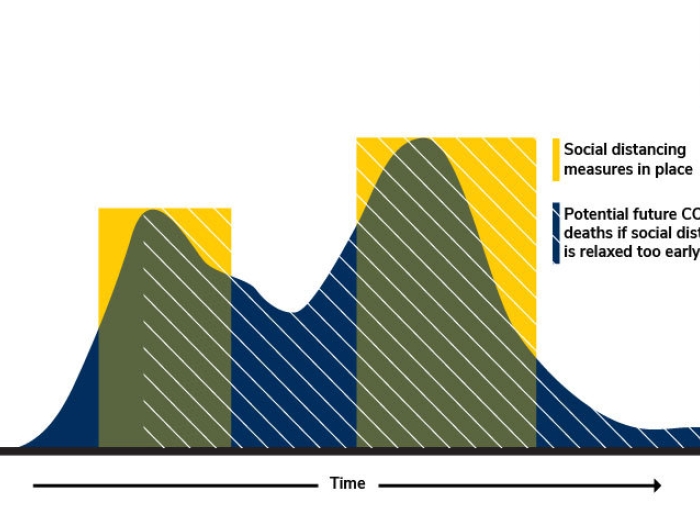Analysis of past flu-related hospital bills suggest an average out-of-pocket cost over $1,000 for serious cases of COVID-19.
8:50 AM
Author |

Nearly 1.7 million times in the past year, Americans have checked into hospitals to get treated for severe cases of COVID-19.
And for the most part, that care hasn't cost them anything, thanks to insurance companies and government programs that absorbed the usual costs patients would owe for any other hospital stay.
But as some insurers phase back in those out-of-pocket costs, a new study estimates that many people over 65 hospitalized for COVID-19 in 2021 may owe an average of nearly $1,000 after they get out of the hospital, due to co-pays, deductibles and co-insurance. A few may owe hundreds or thousands more.
That estimate is based on a new analysis of out-of-pocket costs for influenza-related hospitalizations in 2018 that were paid by people with Medicare Advantage plans, which are Medicare plans run by private insurance companies.
Nearly 40% of Americans over age 65 – who have a high chance of needing hospital-level care if they catch the coronavirus – have the kind of insurance analyzed in the study.
Most insurers that offer Medicare Advantage plans currently cover COVID-19 hospitalization costs fully for their Medicare Advantage enrollees, but one of these insurers quietly started to allow cost-sharing for its non-Medicare Advantage enrollees in February. This raises concerns that cost-sharing waivers may soon be a thing of the past for many or all patients hospitalized for COVID-19.
SEE ALSO: Costs, COVID-19 Risk and Delays Top Older Adults' Concerns About Seeking Emergency Care
"Insurers may choose to extend their waivers for enrollees with Medicare Advantage and private insurance coverage," says Kao-Ping Chua, M.D., Ph.D., the study's first author and an assistant professor at the U-M Medical School. "But if they don't, patients will be faced not only with the physical and emotional toll of COVID-19 hospitalizations, but also the financial toll."
Writing in the American Journal of Preventive Medicine, a pair of health care researchers from the University of Michigan and Boston University describe data from 14,278 people hospitalized during one of the worst flu years in recent times.
On average, the flu patients in the study were hospitalized for an average of 6 days, and one-third of patients needed intensive care. This is around the same or slightly lower than the averages for hospitalized adults over 65 who have COVID-19.
Those who needed intensive care for flu, and those with longer stays at any level of care, faced out-of-pocket costs that were higher than the general average. About 3% of the flu patients faced out-of-pocket costs over $2,500.
Insurers may choose to extend their waivers for enrollees … But if they don't, patients will be faced not only with the physical and emotional toll of COVID-19 hospitalizations, but also the financial toll.Kao-Ping Chua, M.D., Ph.D.
Another study of cost-sharing among people with private non-Medicare insurance who were hospitalized for respiratory infections in pre-COVID times suggests out-of-pocket costs could be even higher for them. In part this is because so many private plans have high deductibles that must be paid each year before insurance coverage fully kicks in.
Chua notes that the choice of flu or other respiratory infection hospitalizations is not a perfect stand-in for COVID-19, which is having far more impact on the United States than even the worst flu year. But it is as close a stand-in as possible.
People with traditional Medicare also must share in the cost of their hospital care, but the current study did not analyze data from people with that form of coverage.
SEE ALSO: COVID-19 Care is (Mostly) Free to Patients. Should Other Vital Care Be Too?
In 2018, 40% of Americans lacked enough savings to pay for a $400 emergency, according to federal data. The pandemic has put even more economic pressure on the lowest-income Americans.
Chua and his co-author Rena Conti, Ph.D., of Boston University's Institute for Health System Innovation and Policy, note that worries about out-of-pocket costs might keep some people from seeking emergency or inpatient care. They call for federal legislation mandating insurers to fully cover the costs of COVID-19 hospitalizations for the duration of the pandemic, and for insurers to extend waivers due to expire soon.
Chua, a pediatrician at Michigan Medicine as well as a health care researcher, is a member of the Susan B. Meister Child Health Evaluation and Research Center and the U-M Institute for Healthcare Policy and Innovation.
The Association of Health Insurance Plans offers a page that tracks private insurers' current policies regarding COVID-19 care, including cost-sharing waivers.
Paper cited: "Out-of-Pocket Spending for Influenza Hospitalizations in Medicare Advantage," American Journal of Preventive Medicine. DOI: 10.1016/j.amepre.2020.11.004

Explore a variety of health care news & stories by visiting the Health Lab home page for more articles.

Department of Communication at Michigan Medicine
Want top health & research news weekly? Sign up for Health Lab’s newsletters today!





